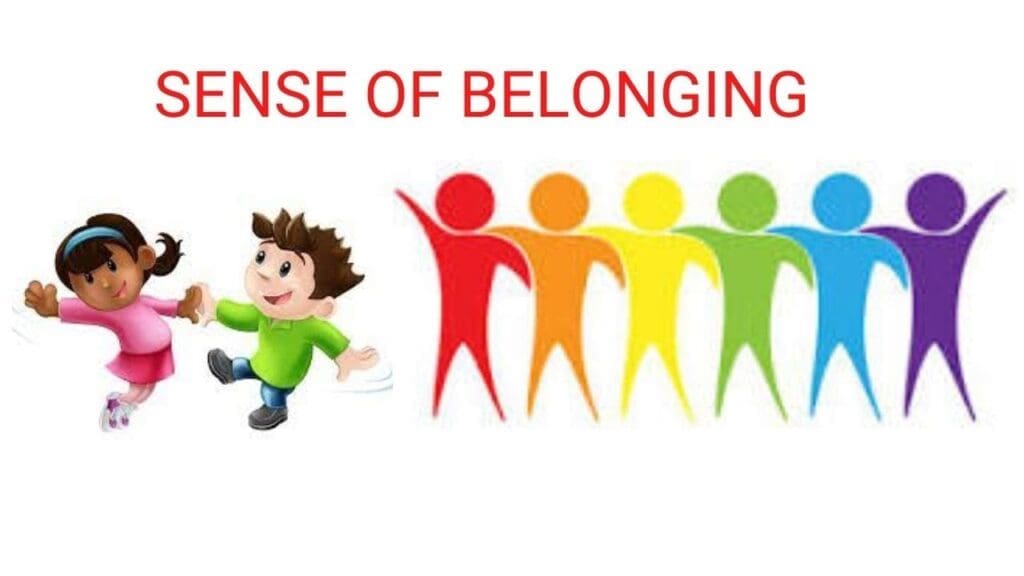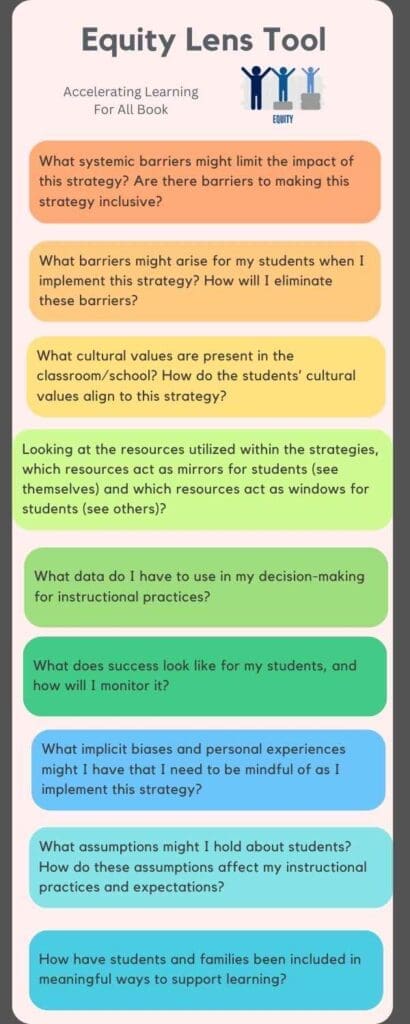Student Sense of Belonging Strategies

How to Build a Strong Foundation for the Year
Student Sense of Belonging strategies are Reflections of Self, Quick Checks, 2 x 10 strategy, Kid watching, and Student and Family Inventories.
These 5 strategies are from authors Colleen Urlik and Rebecca McKinney of Accelerating Learning For All Equity in Action.
These strategies focus on building strong relationships and classroom culture, and lend themselves well to routines and rituals established at the beginning and throughout the school year.
Reflections of Self
This is a Tier one strategy, where educators will begin by explaining the strategy to students. Authors explain how to approach these conversations:
One goal that is important to me is that our classroom is our shared space and reflect all the many things important to each of us. I want all of us to feel safe and comfortable in our classroom, so we will bring in images of people, places, and things that are important to us. You have the next week to use your phone to take pictures of things meaningful to you. If you don’t have a phone, don’t worry, I will have disposable cameras you can borrow. At the end of the week, I will print your pictures. Then you will review your photos, and each of you will select 5 pictures to be displayed in the classroom. We will then frame the photos and put them around the classroom. Authors suggest you use actual frames, because it elevates the importance of students’ images and sets them apart from other things. Post it in the classroom.
You can display photos when using frames on the shelves, window ledges and other areas.
Quick Checks
The goal of quick checks is to intentionally check in and learn about students. This way, educators can consistently gather trend data on students when using quick checks. It can be helpful if student behavior suddenly changes and academic or social emotional intervention is needed. Authors give an example of how to approach these conversations:
It is so nice to see everyone! Please look up at the board to submit your answer to the question today: What are the things in your life that stress you out, and how do you deal with that stress? If there is anything special or in particular you would like me to know, just add it in. Or if you would rather have a quick discussion with me, let me know. (Note – as they work, interact with individual students.) OK, this was an important one today! Stress is common and something everyone experiences. I personally experience stress when I have a long to-do list or when the list isn’t long, but I have not made any progress on completing it. To deal with it, I purposefully find some time where I can focus on completing some parts of the list. I find that usually if I sit down and focus, I can get through some of it faster than I thought. Has anyone else ever felt this way? Would anyone else like to share?
Authors provide possible check-in Starters:
- Tell me how you are doing.
- What are you excited about today?
- What makes you feel welcome at school? What would you change if you could?
- Is there anything worrying you?
- Is there anything you want me to know about how you are doing today?
- What haven’t I asked about that you want me to know?
Educators can do a quick check-in as a warm-up activity with the whole class, with this example. You can use technology or write on a slip of paper. You can use similar questions during exit slips, class meetings, or if restorative practices are utilized, during Connection Circles – a restorative practice strategy that seeks to build and support ongoing relationships through listening, understanding, sharing experiences, thoughtful discussion and supporting positive conflict resolution.
Quick Checks is also an excellent place to integrate student reflection strategies, like temperature checks, where students reflect on their current understanding or feeling of content in relation to some type of representation. This could be a thermometer (temperature check), a scale of one to five, or visuals like emojis or gifs. You can also use the quick checks during small group instruction for individual check-in or conference.
2 x 10 Strategy
This strategy is “the two minute intervention” introduced by researcher Raymond Woldkowski (1983), where staff dedicate 2 minutes per day for 10 days in a row, speaking directly to a student about something beyond school. This strategy is a Tier 2 strategy popularized by Allen Mendler to support students who need additional intentional check-in time to build relationships and strong classroom culture. It can be an extension of Quick Check-in.
You can model 2 x 10 strategy by sharing something nonacademic with students. Authors Mckinney and Urlik provide an example of how to approach the conversations: I heard you love to work on cars! My dad restored Model Ts as I was growing up. What cars do you work on? Who do you work on them with?
2 x 10 Discussion Starters
McKinney and Urlik provide 2 x 10 discussion starters you can use with students:
- Tell me what you are excited about outside school.
- Tell me about your hobbies.
- What do you do in your free times?
- If you could meet any person, who would it be?
- What is the one thing you did yesterday? What one thing are you looking forward to today?
- What are you good at?
- What do you want to do when you grow up?
- What is something I don’t know about that you wish I knew?
- What haven’t I asked you about what you want me to know?
McKinney and Urlik suggest you ask follow up questions specific to the student’s response. McKinney and Urlik caution do not be tempted to change the focus of 2 x 10s to school related topics like classwork or behavior.
Kidwatching
A tool for observation of developmental milestones into a Tier 1 strategy to better understand your students’ academic and social emotional needs. Kidwatching involves observing three to five students a week and making notes about observations of each student. Observations can be planned around academic or social tasks, depending on the purpose. Mckinney and Urlik show an example of observing Javier for assessment purposes. Javier appears extremely anxious and rushes through his assessment. His teacher tried to assure him during and after the assessment, and finds out Javier gets nervous because he wants to do well and be the first to go to college. Javier has a strong goal, but it seems to get in the way of his ability to demonstrate his skills and understanding. Javier’s teacher had a lengthy conversation about his goals and fears, and together developed a plan to control the stress and perfectionism he was placing on himself.
Student and Family Inventories
McKinney and Urlik believe student inventories are a great way to get to know students from the people who know them best – themselves and their families. The language and content should be adapted to meet the needs of students and family within the community being served. McKinney and Urlik suggest first have a clear purpose on how the information is gathered through these inventories will be used. This will guide the decision on what to ask. McKinney and Urlik give several examples of how to use the purpose to tailor the questions to students. These questions can easily be adapted for a family inventory. See Inventory Purpose and Supporting Question Table Below:
| Purpose For Inventory | Potential Question |
| If Your Purpose is to Determine Students’ — | Then ask — |
| Culture, family, and important personal information | Tell me about your family. What important events do you celebrate? What beliefs are you passionate about? What else would you like me to know about your family culture, or community? |
| Experiences | What has been an impactful experience for you? |
| Learning behaviors | How do you like to learn? What is your favorite subject? Why? What is your least favorite subject? Why?What motivates you? |
| Interests | What do you enjoy outside of school? What do you enjoy at school? If you could meet one person, who would it be? |
| Knowledge of content | What do you know about ________? If you could learn anything about ______ what would you want to know? , What connections might you see between ________and something you know about? (such as baseball, music, and gaming – suggestions can be targeted to individual student interests or community culture, such as a sports team, local pastime, etc.) |
| Other general information | What haven’t I asked about that you would like me to know? |
Please use the Equity Lens Tool below for the 5 Strategies:

You can find this post on Building UnBiase Learning Environment Page.
